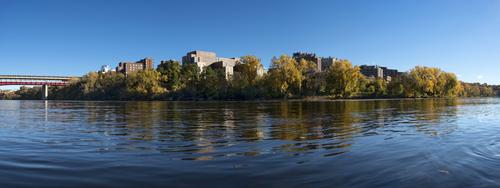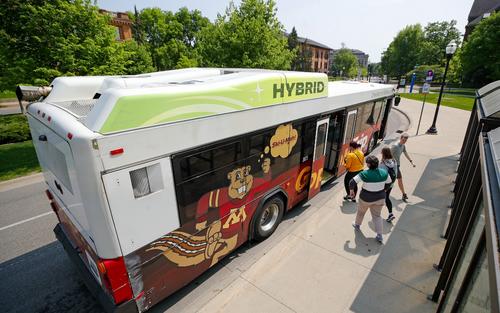
Creating a sustainable campus
See how the U of M is building a fully sustainable future by
Climate change is one of the greatest challenges of the 21st century. It’s already affecting communities and ecosystems in Minnesota and around the world.
That’s why the University of Minnesota is taking aggressive action to meet its climate goals as quickly as possible. In 2021, the University created a systemwide strategic plan, MPact 2025, which calls out “building a fully sustainable future” as a core commitment for the University.
Now, the University of Minnesota Twin Cities has released a new Climate Action Plan (CAP) that looks toward the future of carbon neutrality and resiliency on campus. It’s a plan that builds on the University's history of sustainability leadership and identifies new actions to eliminate carbon emissions as quickly as possible and adapt to a changing climate. The CAP aims to reduce U of M Twin Cities emissions 60 percent by 2033 (from 2019 levels) and to become completely carbon neutral by 2050.
And while the new CAP sets a pace to eliminate campus greenhouse gas emissions by 2050, the plan has a 10-year horizon that outlines specific actions that need to be achieved by 2033. That includes ambitious actions to reduce energy use on campus, supply more of the campus's energy needs from renewable sources, and rightsize and electrify campus fleet vehicles. The CAP also includes the University’s first climate vulnerability and strength assessment, which will be a foundation for future resiliency planning.

“Our campus community and state overwhelmingly agree that climate change is a critical area of focus, and we know the costs of inaction far outweigh the investment needed to build a sustainable future.”
Shane Stennes, U of M’s Chief Sustainability Officer
More than 3,000 students, faculty, staff, and community members were engaged in developing the plan, which was led by the Twin Cities Sustainability Committee with support from the Office of Sustainability.
“Our campus community and state overwhelmingly agree that climate change is a critical area of focus, and we know the costs of inaction far outweigh the investment needed to build a sustainable future,” says the U of M’s first Chief Sustainability Officer Shane Stennes, who leads the Office of Sustainability. “Business as usual will not achieve the transformational results we need.”
Here, we detail some of the University’s many sustainability accomplishments so far, as well as the work to come.
Equity and environmental justice in sustainability
Diverse communities on and off campus were engaged in the CAP planning process, including local neighborhood associations and campus organizations like the Diversity Community of Practice, the Circle of Indigenous Nations, and the Office for Multicultural Student Engagement.
The burdens of environmental pollution, including those associated with climate change, are disproportionately borne by Black, Indigenous, and people of color communities, people in poverty, and the disenfranchised. While the CAP partially addresses this issue, much more remains to be done. That’s why environmental justice is identified in the CAP as a critical issue for future University work.